The Leshan Giant Buddha (乐山大佛) is a majestic and awe-inspiring statue located in Leshan City, Sichuan Province, China. Carved out of a cliff face during the Tang Dynasty, it is considered one of the most extraordinary Buddhist sculptures in the world. The statue depicts Maitreya, the future Buddha, seated with his hands resting on his knees, looking out over the confluence of three rivers.
Standing at a staggering height of approximately 71 meters (233 feet), the Leshan Giant Buddha is the largest stone Buddha statue in existence. Its construction began in the year 713 AD and took over 90 years to complete. It is a remarkable feat of engineering and craftsmanship, utilizing advanced techniques of that era.
The statue’s serene expression, intricate details, and sheer size make it a marvel to behold. Visitors can admire the statue from various angles, either by walking down the steps that flank it or by taking a boat ride to see it from the water. The Leshan Giant Buddha has become a popular pilgrimage site for Buddhists and a renowned tourist attraction, attracting millions of visitors from around the world each year.
In addition to its religious significance, the Leshan Giant Buddha is also recognized as a UNESCO World Heritage Site, further emphasizing its cultural and historical importance. This magnificent sculpture stands as a testament to the skill, dedication, and artistic achievements of ancient China, captivating all who encounter it with its grandeur and spiritual presence.
Table of Contents
- Location and Transportation
- Highlights of Leshan Giant Buddha
- Map and Recommended Routes
- Building Process of Leshan Giant Buddha
- History of Leshan Giant Buddha
- Useful Tips from Genuine Reviews
Basic Information
| Website | http://www.lsdf517.com/ |
| Estimated Length of Tour | Over 3 hours |
| Ticket Price | 80 RMB |
| Opening Hours | 7.30 – 18.30 (1st April – 7th October) 8.30 – 17.30 (8th October – 31st March the next year) |
| Boat Cruise Price | 70 RMB |
| Boat Cruise Operating Hours | 7.30 – 18.00 (1st April – 7th October) 8.00 – 17.00 (8th October – 31st March the next year) |
| Telephone Number | 0086-0833-2355557 0086-0833-2126582 |
Location and Transportation
The Leshan Giant Buddha is situated in Leshan City, which is located in the southwestern part of Sichuan Province, China. Leshan City itself is nestled at the confluence of the Minjiang, Dadu, and Qingyi rivers, creating a picturesque natural setting for this colossal statue. The statue is specifically situated on Lingyun Mountain, facing the junction of the three rivers. To get there, you can choose the following ways (How to get to Leshan giant Buddha from Chengdu):
- Take bus 4, 201, 302, 601, 602, or K1, get off at Jiadingfang Stop (嘉定坊站), and walk about 100 meters to the south to reach the area.
- Take bus 3, 13, 302, 601, or K1, get off at Leshan Giant Buddha Stop (乐山大佛站), and walk about 200 meters to the west to reach the area.
Highlights of Leshan Giant Buddha
Intricate Stone Hair Curls
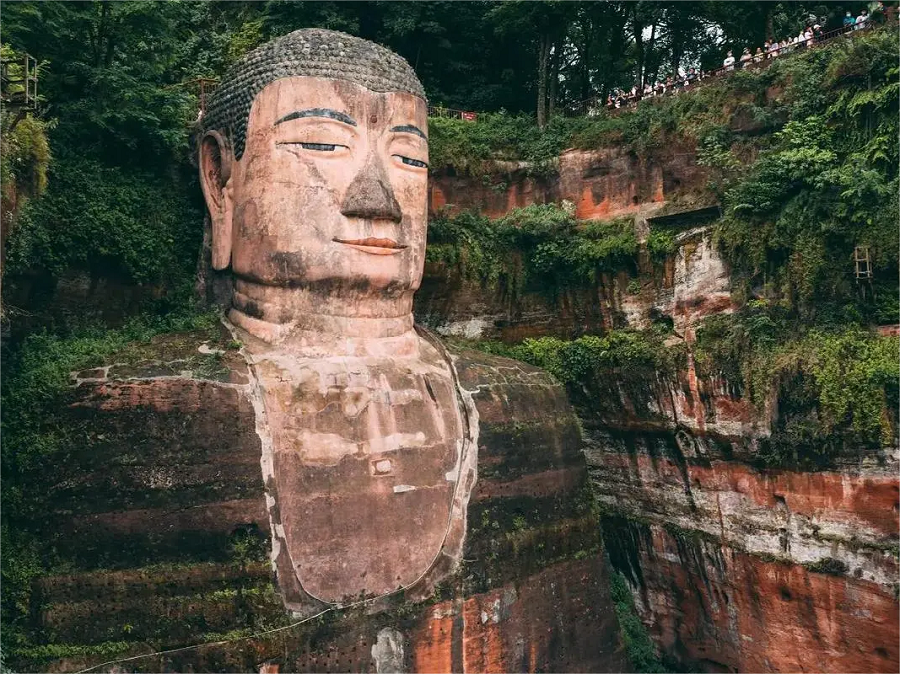
Atop the head of the Leshan Giant Buddha, there are 1,051 spiral hair curls, known as “螺髻” (luó jì). These were counted and numbered during a restoration effort in 1962 using chalk. From a distance, these hair curls appear to seamlessly merge with the Buddha’s head. However, they are actually individual stone pieces intricately embedded into the sculpture. Each curl has a distinct groove where it fits into the head without the use of mortar. The surface of each curl is coated with two layers of plaster, the inner layer being lime with a thickness ranging from 5 to 15 millimeters. During the 1991 restoration, three hair curl stones were discovered in the recessed area of the Buddha’s right leg, two of which were relatively intact. These curls measure 78 centimeters in length, with the top dimensions being 31.5 x 31.5 centimeters and the base dimensions being 24 x 24 centimeters.
Plank Road and Guardian Kings
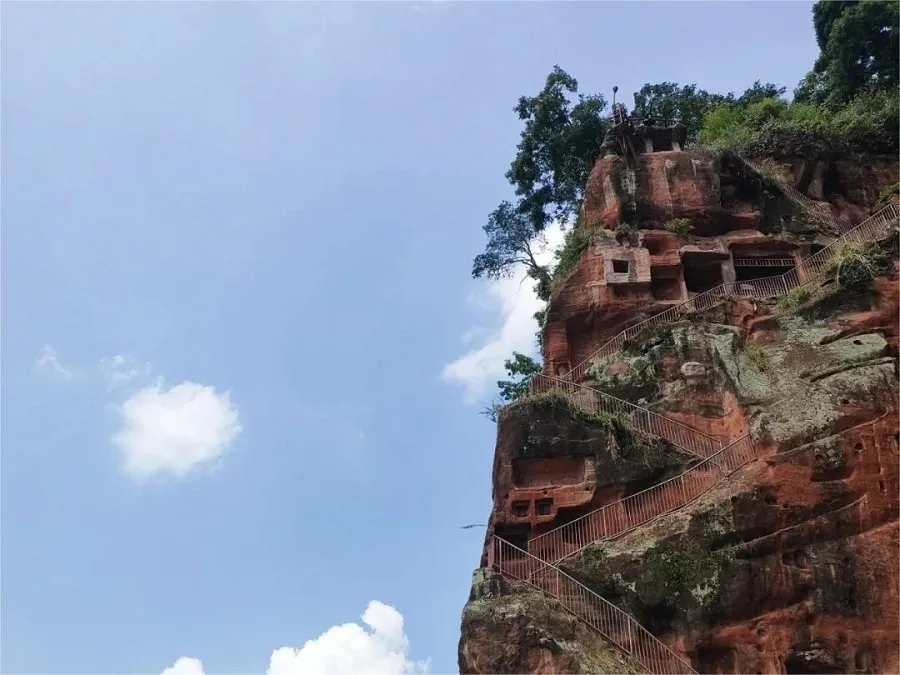
Flanking the Giant Buddha on both sides of the cliff are two imposing statues of guardian kings, each standing over 16 meters tall. These stone-carved guardians add to the grandeur and protective aura of the site. The right side of the Buddha features a treacherous Nine Bends Plank Road, an ancient path carved into the cliff face during the Tang Dynasty. This path was originally used during the construction of the Buddha and served as a pilgrimage route for worshippers. The path winds and twists perilously along the sheer rock face, providing a dramatic and challenging journey for those who traverse it.
Historically, the Leshan Giant Buddha was once sheltered by a grand pavilion known as the “大佛阁” (Dà Fó Gé) or “大像阁” (Dà Xiàng Gé). According to various historical records, this pavilion ranged from seven to thirteen stories high and served to protect the Buddha from the elements. However, it was repeatedly destroyed and rebuilt over the centuries.
Lingyun Temple
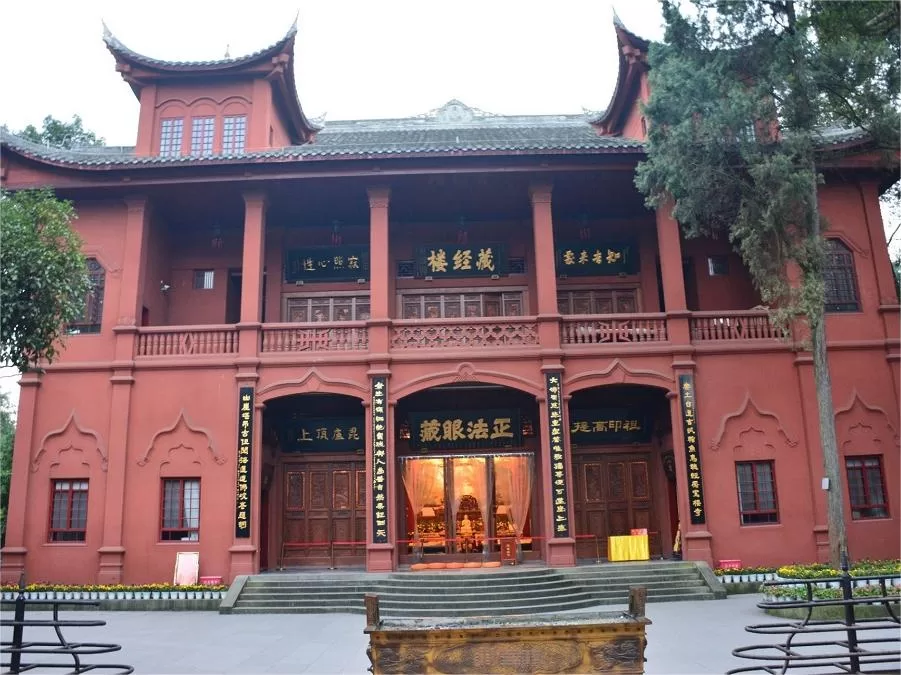
Lingyun Temple (凌云寺) is an ancient Buddhist temple located within the Leshan Giant Buddha Scenic Area. Dating back to the Tang Dynasty, the temple adds a spiritual ambiance to the area surrounding the giant Buddha. It has undergone reconstruction and renovations over the years, preserving its historical and cultural significance. The temple features traditional Chinese architecture, intricate wood carvings, and beautiful Buddhist statues. Visitors can explore the temple grounds, immerse themselves in its tranquil atmosphere, and appreciate the artistry and religious devotion that make Lingyun Temple an integral part of the Leshan Giant Buddha experience.
Wuyou Temple
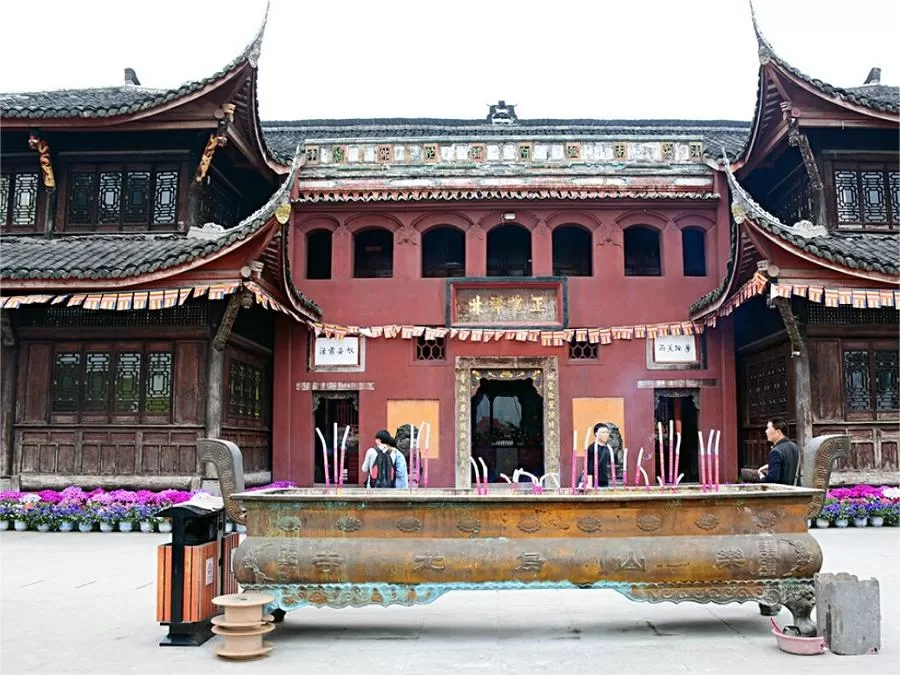
Situated on the eastern side of the giant Buddha, the ancient Wuyou Temple (乌尤寺) offers a peaceful and contemplative environment. Surrounded by lush gardens and scenic beauty, Wuyou Temple provides visitors with a tranquil retreat. The temple showcases exquisite traditional Chinese architecture and houses a collection of Buddhist statues and artifacts. It is a place for spiritual reflection, meditation, and cultural exploration. The peaceful ambiance of Wuyou Temple adds to the overall experience of the Leshan Giant Buddha area, inviting visitors to connect with their inner selves and embrace the serenity of the surroundings.
Mount Lingyun
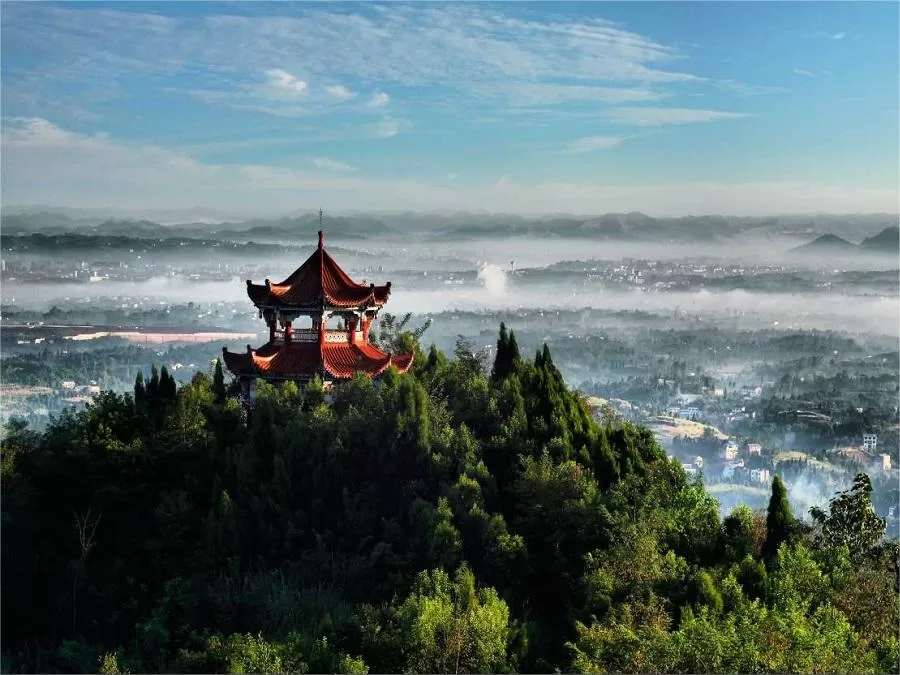
Mount Lingyun is a picturesque mountain located within the Leshan Giant Buddha Scenic Area. Offering breathtaking views and natural beauty, it serves as a backdrop to the grandeur of the giant Buddha statue. Visitors can explore Mount Lingyun’s scenic trails, which meander through lush greenery and showcase cascading waterfalls. The mountain provides vantage points that offer stunning panoramic views of the surrounding landscape, including the giant Buddha and the convergence of rivers. Hiking in this tranquil setting allows visitors to immerse themselves in nature, appreciate the awe-inspiring scenery, and capture memorable moments amidst the beauty of Mount Lingyun.
Boat Tours
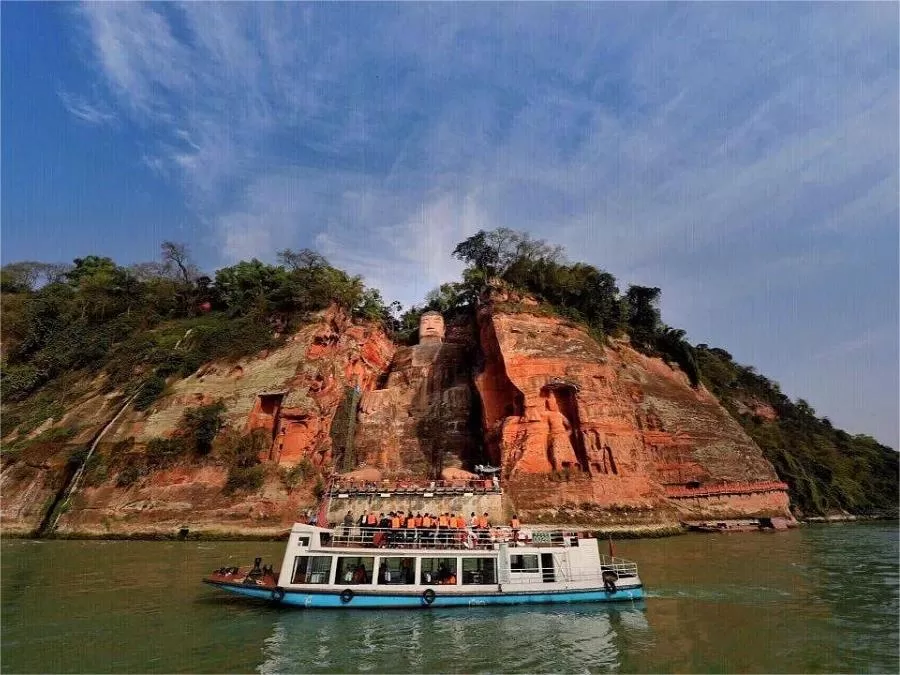
Boat tours offer a unique and enchanting perspective. Visitors can embark on a boat ride along the rivers that flow below the giant Buddha, providing an up-close and awe-inspiring view of the colossal statue. As the boat glides through the water, passengers can witness the immense scale of the Buddha, marvel at its intricate details, and soak in the surrounding natural beauty. These boat tours offer a serene and picturesque experience, allowing visitors to appreciate the harmonious integration of the magnificent sculpture with the flowing rivers and stunning landscapes of the Leshan Giant Buddha area.
Map and Recommended Routes
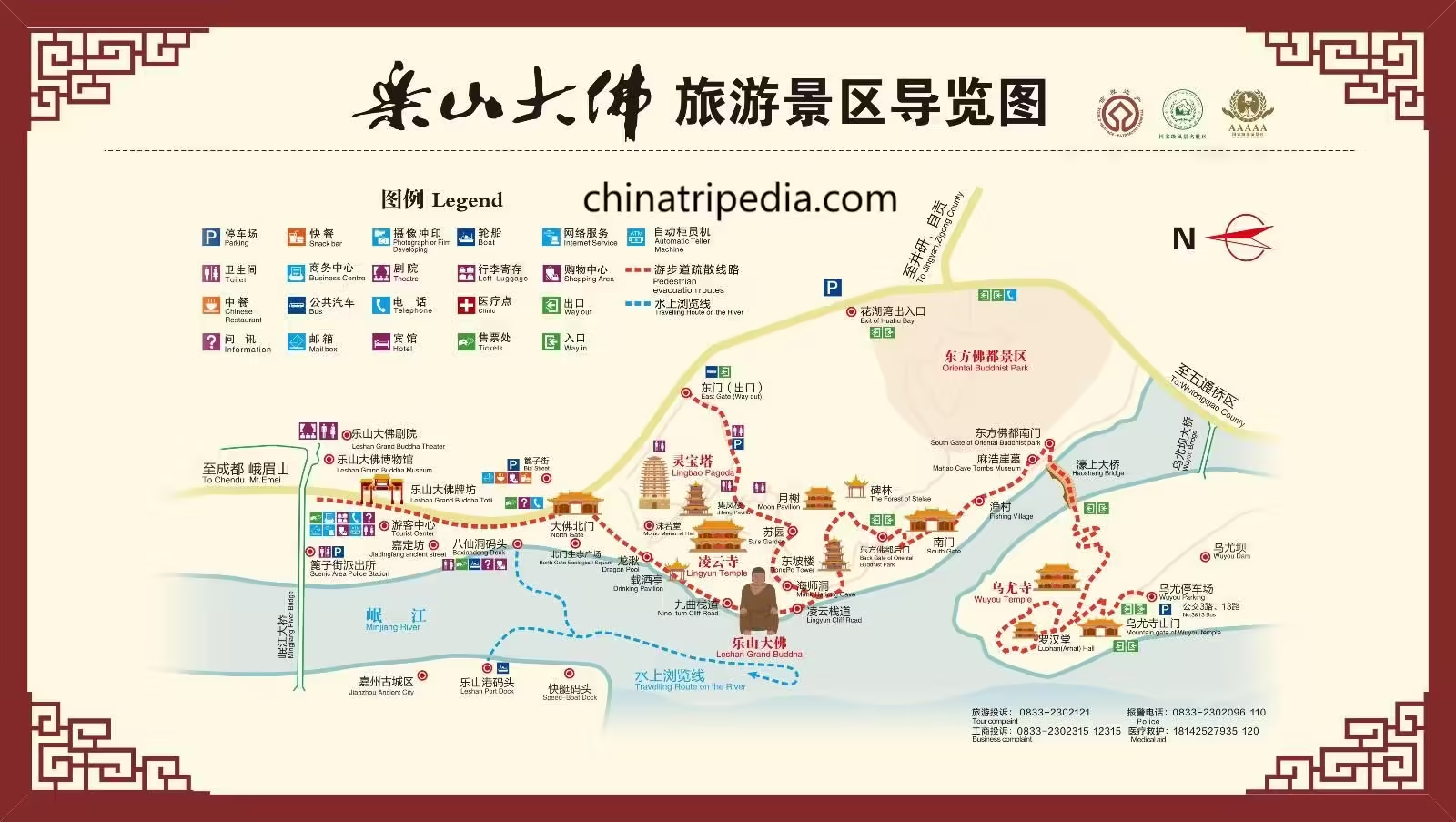
Route 1: North Gate Entry, East Gate Exit
- To the Buddha: Start at the North Gate → Fomen (Buddhist Gate) → Ancient Worship Path → Longqiu (Dragon Pool) → Tiger Cave → Zaijiu Pavilion → Doushuai Palace → Arrive at Leshan Giant Buddha. You can choose to take the Nine Bends Plank Road down to the Buddha’s feet for a closer view.
- Return: Haishi Cave → Dongpo Tower → Lingyun Temple → Lingbao Pagoda → Moruo Hall → Follow the mountain path down to the East Gate Exit.
- Duration: Approximately 3 hours.
Route 2: North Gate Entry, Wuyou Temple Exit
- To the Buddha: Start at the North Gate → Ancient Worship Path → Leshan Giant Buddha → Lingyun Temple, Lingbao Pagoda, Moruo Hall → Maha Cliff Tomb → Wuyou Temple → Exit via Wuyou Temple Main Gate.
- Duration: This route is relatively longer and can be adjusted based on walking speed and personal interest.
Route 3: Water Route (View the Giant Buddha and Sleeping Buddha)
- To the Buddha: Board the boat at Jiazhou Ferry Dock → Enjoy views of the Giant Sleeping Buddha along the waterway → Jiulong Beach → Sanjiangkou. The boat stops for a close-up view of the Leshan Giant Buddha, perfect for photos.
- Return: Wuyou Mountain → Fengzhou Island → Return to the dock.
- Duration: About 60 minutes (including a 10-minute stop in front of the Buddha).
Route 4: Water + Land
- To the Buddha: Jiazhou Ferry Dock → Giant Sleeping Buddha → Jiulong Beach → Sanjiangkou → Wuyou Temple, Maha Cliff Tomb, Buddha Paradise, Stele Forest.
- Return: Lingyun Plank Road → Return to Leshan Giant Buddha → Lingyun Temple.
- Duration: Depends on the specific activities chosen.
Building Process of Leshan Giant Buddha
History of Leshan Giant Buddha
The history of the Leshan Giant Buddha dates back to the early Tang Dynasty. The construction officially began in 713 AD during the reign of Emperor Xuanzong (Tang Kaiyuan period) and was initiated by a monk named Haitong. However, after Haitong passed away, the project came to a halt due to a lack of funds.
In 739 AD, during the 27th year of the Kaiyuan era, Zhangchou Jianqiong, the military governor of Xichuan in Jiannan Dao, took notice of the unfinished Buddha. He generously donated 200,000 coins from his salary to resume the construction. Despite this large contribution, the massive project still faced financial difficulties. The story of the unfinished Buddha eventually reached Emperor Xuanzong, who decreed that the taxes collected from the sale of salt should be used to fund the Buddha’s construction.
In May 746 AD, Zhangchou Jianqiong was promoted to Minister of Revenue and had to return to Chang’an. His departure caused the funds to run out again, leading to another suspension of the project.
Finally, in 789 AD, the project was revived for the third time, and after nearly 90 years of intermittent construction, the Leshan Giant Buddha was completed in 803 AD, during the 19th year of the Zhenyuan era.
Useful Tips from Genuine Reviews
Transportation from Leshan Station: Upon arrival at Leshan Station, it’s recommended to queue for a taxi directly outside, as it is both cheap and convenient. The entire journey should cost around 25-30 yuan.
Choosing the Taxi Drop-off Point: When taking a taxi, opt for the endpoint at “6th Parking Lot, Gate 2,” as it is the closest entrance with minimal walking distance, saving a considerable amount of time.
Avoiding the “Scenic Area Direct Shuttle” from the High-Speed Rail Exit: Although there are signs for “Scenic Area Direct Shuttle” at the high-speed rail exit, it is advised not to take it. It costs 10 yuan per person and mainly promotes the Eastern Buddha Cave (additional 80 yuan entrance fee) built quite recently. It’s not highly recommended unless one is interested in sculptures or related culture.
Two Touring Options: Climbing and Boat Tour: There are two ways to explore the site: climbing with an 80 yuan ticket or taking a boat tour with a 70 yuan ticket. Climbing allows you to see the Buddha’s head at the mountaintop and descend to the feet via a plank walkway. However, after viewing the feet, there is a need to climb 20 more floors to return to the mountaintop. The boat tour provides a panoramic view of the Giant Buddha. The boat stops for 5 minutes in front of the Buddha for photography, offering a better perspective.
Post-Tour Options: After the visit, one can exit from the East Gate and head straight to Zhanggong Bridge Snack Street, East Street, or try the “Ye Popo Bobo Chicken” for a meal.

0 Comment